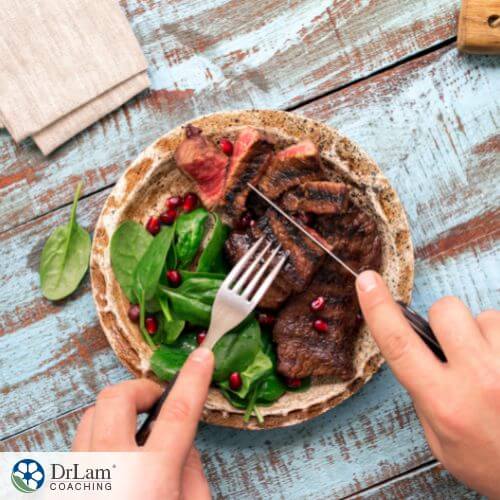Pierre Dukan, a French doctor and nutritionist, designed the Dukan Diet in 2000. Although it has gained popularity as a diet that allows you to quickly lose weight and sustain the weight loss, some health experts feel the diet is unhealthy with too many restrictions.
 A low-carbohydrate, high-protein diet, the Dukan Diet provides a list of one hundred foods that you can eat. Of these one hundred, thirty-two are vegetables and sixty-eight are pure proteins. You can eat as many of these foods as you like without restrictions. Also, the diet includes other foods as you progress through the separate phases of the diet.
A low-carbohydrate, high-protein diet, the Dukan Diet provides a list of one hundred foods that you can eat. Of these one hundred, thirty-two are vegetables and sixty-eight are pure proteins. You can eat as many of these foods as you like without restrictions. Also, the diet includes other foods as you progress through the separate phases of the diet.
The theory behind the diet is that a high-protein diet promotes weight loss because proteins have fewer calories than carbohydrates. Proteins also promote a feeling of fullness, while your body’s digestive process uses more energy to digest them. The diet further promotes weight loss because restricting your carbohydrate and fat intake promotes a starvation state in your body, forcing it to use stored fats to provide your energy requirements.
The Dukan Diet works in phases. During each phase, you can eat as much as you like as long as you stick to the specific foods outlined in the phase. Before starting the diet, you need to establish your goal weight. This involves considering various factors like your height, age, bone structure, and others. Once you have this established, you can start with the diet.
Note that each phase of the diet has its own set of aims and limitations, although the last phase has a larger variety of foods to choose from.
The attack phase usually lasts up to five days. Those wishing to lose more than forty pounds in total cold stay in this phase for longer than seven days. The attack phase of the Dukan Diet involves eating many protein-rich foods to boost your metabolism.
Most people lose weight during this phase because a reduction in carbohydrates tends to reduce the water content of the body. Because this quick loss in water content may result in dehydration, you should drink plenty of water during this time.
During the attack phase, you can eat as much of the sixty-eight proteins on the list as you wish. You do not need to count calories. But besides drinking plenty of water, you should also exercise for a minimum of twenty minutes a day and eat at least one and a half tablespoons of oat bran each day. Oat bran helps with hunger suppression.
This phase aims at slower weight loss. Besides the protein from the attack phase, you can also eat all the vegetables on the permitted list. Ideally, you should alternate your diet by eating pure protein one day and a protein and vegetable combination the next.
You can stay on the cruise phase of the Dukan Diet for as long as you like. Aim for three days for every pound you wish to get rid of. You should also, during this phase, increase your exercise to up to sixty minutes per day and your oat bran serving to two tablespoons.
 The third phase of the Dukan Diet does not aim at losing weight but at not regaining it. Here, you add some starchy foods to your diet once or twice per week while having two celebration meals as well. Celebration meals are those where you can eat whatever you wish. However, you also reserve one day solely for protein like during the attack phase of the diet, ideally on the same day each week.
The third phase of the Dukan Diet does not aim at losing weight but at not regaining it. Here, you add some starchy foods to your diet once or twice per week while having two celebration meals as well. Celebration meals are those where you can eat whatever you wish. However, you also reserve one day solely for protein like during the attack phase of the diet, ideally on the same day each week.
During this phase, twenty-five minutes of exercise per day is required. You should follow this phase for five days per every pound lost.
The stabilization phase deals with long-term maintenance. You should not gain or lose weight while in this phase. It should become part of your lifestyle.
With regards to the rules, you can eat whatever you want, but you still need to get in twenty minutes of exercise each day, have one pure protein day on the same day each week, drink plenty of water, and eat three tablespoons of oat brain daily.
What you can and can not eat depends on the phase of the Dukan Diet you are in.
Do note this diet is suitable for vegetarians and vegans alike as they can choose from plant-based protein sources when considering their protein consumption. People following a gluten-free diet can also benefit from the Dukan Diet.
Please note to always drink plenty of water and incorporate your oat bran into your diet each day, no matter what phase of the diet you currently follow.
This stage consists of high-protein animal or plant-based foods that include the following:
The cruise phase allows for the incorporation of certain vegetables. Fortunately, the large variety allowed should suit most tastes. These vegetables include:
Besides the proteins and vegetables already mentioned, the consolidation phase of the Dukan Diet allows the addition of the following for the first half of this phase. Do remember that you should follow the consolidation phase guidelines, i.e., five days per pound lost. So, if you lost ten pounds, you should follow this phase of the diet for fifty days.
The dietary requirements during this period are split into two.
The first half of the consolidation phase allows you to incorporate the following:
The second half of the consolidation phase allows you to incorporate the following as well:
The stabilization phase aims to maintain a healthy weight in the long term. You can eat anything you like during this phase, although you should keep up your exercise regime, consume three tablespoons of oat bran each day, and reserve one day per week for only proteins from the attack phase of the diet.
 Although little research has been conducted on the Dukan Diet and its benefits, studies do show that a diet high in proteins and low in carbohydrates can significantly help with weight loss. It may also increase your metabolism, promote a feeling of fullness, and increase your body’s fat-burning capacity. A higher protein intake may also reduce your ghrelin levels. Ghrelin is the hunger-stimulating hormone.
Although little research has been conducted on the Dukan Diet and its benefits, studies do show that a diet high in proteins and low in carbohydrates can significantly help with weight loss. It may also increase your metabolism, promote a feeling of fullness, and increase your body’s fat-burning capacity. A higher protein intake may also reduce your ghrelin levels. Ghrelin is the hunger-stimulating hormone.
The diet is also specific about food choices. This makes it relatively easy to follow. Also, it does not rely on the need for expensive additives like powders or shakes. It would thus easily fall within an average grocery budget.
With regards to the cons, the diet is relatively restricted. It may also limit your intake of several vitamins and minerals as well as healthy fats. It could also result in an excessive intake of vitamins A, D, and B2, as well as potassium and iron. On the negative side, it fosters a lower folate and vitamin C intake.
Furthermore, the diet’s limitations may cause cravings. Cravings often lead to bouts of unhealthy eating. The excessively high proteins consumed during the diet could also be stored as fat in the body or trigger gout. Gout, a type of arthritis, is associated with inflammation and pain in your joints. A high protein diet may also increase your risk of kidney stones.
Setting up a Dukan Diet meal plan is relatively easy because of the clear restrictions of each stage of the diet. A sample meal plan for a day in each of the distinct phases follows.
This phase allows you to eat anything you want. Do, however, remember to keep moderation in mind. Also, remember to reserve one day in the week for eating as if you are in the attack phase of the diet.
The Dukan, keto, and Atkins diets all put forward the idea of cutting down on carbohydrates to lose weight. And while the three are similar in many ways, they do have noticeable differences.
The Dukan diet, in its early phases, promotes high protein to encourage the burning of fat and not carbohydrates. This is referred to as ketosis. The keto diet, while cutting down on carbohydrates, encourages an increase in fat intake to provide your body with fuel. The keto diet’s protein intake is also much less than that of the Dukan diet.
With regards to the Dukan and Atkins diets, both focus on cutting down on carbohydrates and upping your protein intake. The main difference is that the Dukan Diet also cuts down on your fat intake, while the Atkins diet allows you to eat as much protein and fat as you wish.
Obesity results from a Bioenergetics Circuit dysfunction. Your Bioenergetics Circuit, one of the components of your body’s NeuroEndoMetabolic (NEM) stress response, is responsible for the creation and flow of energy throughout your body.
The three main organ systems of your Bioenergetic Circuit - the liver, pancreas, and thyroid gland - work together to provide every cell in your body with the energy needed to carry out its function. When something happens to compromise your Bioenergetic Circuit function, it results in a downward spiral of events that affects every system in your body.
 The main cause of this is stress. Stress is not only limited to the psychological stress one may experience due to a demanding work environment or personal issues. It includes stressors such as exposure to toxins, health conditions resulting from viral or bacterial infections, and even the stress of an injury or illness.
The main cause of this is stress. Stress is not only limited to the psychological stress one may experience due to a demanding work environment or personal issues. It includes stressors such as exposure to toxins, health conditions resulting from viral or bacterial infections, and even the stress of an injury or illness.
Stress results in the release of stress hormones like cortisol, and while your cortisol production and other body functions return to normal once the stressor goes away, constant stress may see a constant demand for higher and even increasing cortisol production. Your adrenals may be unable to keep up with this demand for cortisol, leading to hormone imbalances and health problems.
The latter stages of adrenal fatigue have disastrous consequences on your body and may impair the function of the various systems forming part of the NEM stress response. This includes your Bioenergetics Circuit.
Obesity and metabolic disorders are symptoms of Bioenergetics Circuit dysfunction. Both involve insulin resistance. Your body may find it increasingly difficult to correctly metabolize carbohydrates and glucose, storing them as fat. This may result in obesity. Symptoms associated with metabolic disorders include faster aging, heart issues, and diabetes.
A diet high in protein and low in sugar, fat, and carbohydrates like the Dukan Diet may help address these issues.
While this diet may promote weight loss, there is not enough literature as yet to comment on its long-term use. What is known is that it is a relatively restrictive diet that may cause certain nutritional deficiencies. Those with adrenal fatigue or who suffer from its various symptoms may be at risk. But this is true of most diets not specifically designed to address adrenal issues.
Furthermore, it is suggested that those with kidney issues, gout, or liver disease should not consider the Dukan Diet. Furthermore, if you have underlying health issues or specialized nutritional needs, please consult your healthcare practitioner before starting this diet. They are best able to determine whether it would prove effective when taking your health history and medications use into account.
The Dukan Diet focuses on high protein intake, low fat, and vegetables. It works in three primary phases and a stabilization phase. It may promote weight loss, especially during the first two phases of the diet. Yet the diet’s restrictions may cause cravings in some people, resulting in over-eating or indulging in sweet and other unhealthy treats. It is always best to consult a healthcare provider before starting any new diet.
If you would like to know more about the suitability of the Dukan Diet or other similar diet options, the team at Dr. Lam Coaching can help. We offer a free** no-obligation phone consultation at +1 (626) 571-1234. We will privately discuss your concerns and offer viable solutions. Alternatively, please post a question through our Ask The Doctor system by clicking here.
Many people may be able to safely follow the Dukan Diet, including vegetarians, vegans, and people on a gluten-free diet. However, some medical conditions may make this diet unsuitable. This might include kidney problems, pregnancy, advanced adrenal fatigue, and others. If you have a medical condition, you should first seek medical advice before starting this diet.
